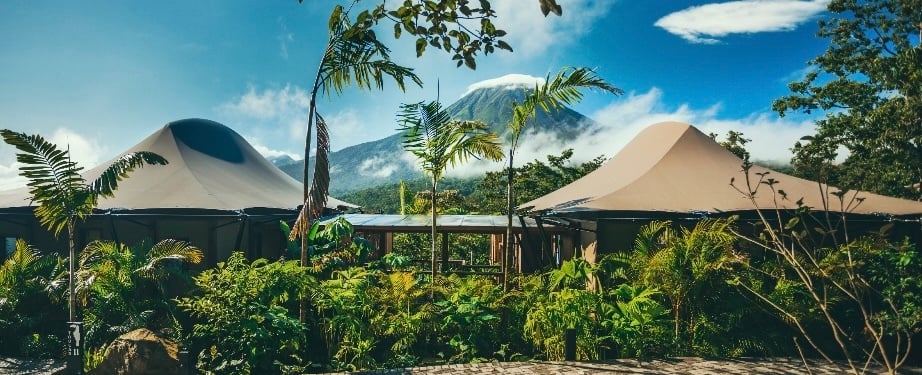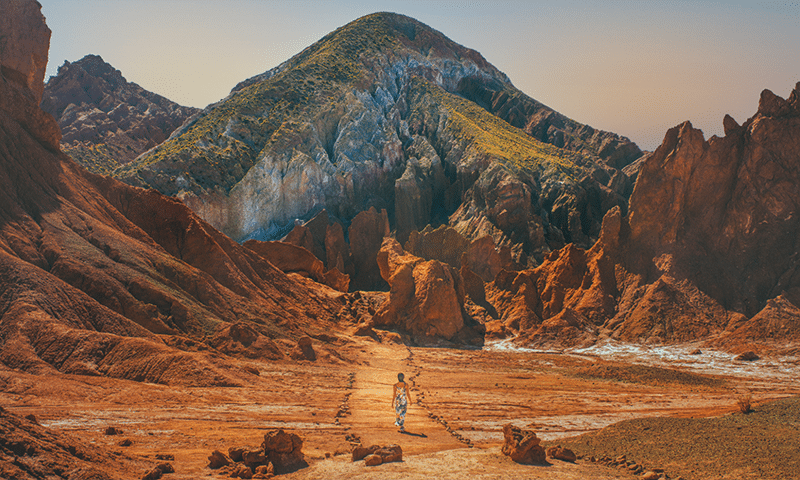From Mars to Atacama: The Future of Regenerative Travel
Mars on Earth
Tourism is one of the most powerful forces on Earth. Done right, it fuels economies, protects ecosystems, and uplifts communities. Done wrong, it erodes cultures, accelerates climate change, and diminishes the very wonders we cross oceans to experience.
At Nayara, pursuit of the former is our raison d’être.
For centuries, travel was limited by geography. We crossed rivers, scaled mountains, and sailed oceans, chasing horizons that always seemed to stretch farther. Today, the frontier feels smaller, yet infinitely larger.
Tomorrow’s horizon is not another coastline or mountain range. It is another planet.
But for most of us, it won’t be reached by rocket.
The Atacama Desert is Earth’s closest analogue to Mars. Its salt flats, volcanic plateaus, and valleys of stone are so stark that NASA and the European Space Agency send rovers here before they ever touch Martian soil. Astronauts trabin on its barren ground. Some pockets are so dry and salty that no microbial life has ever been found — a sterility that mirrors the very question scientists have asked for centuries: is Mars dead, or did it once breathe with life?
In the heart of this otherworldly desert stands Nayara Alto Atacama, a lodge shaped from the terracotta cliffs of the Catarpe Valley. It feels less built than unearthed, as if it belongs to the landscape itself. Nights reveal the clearest skies on Earth, which can be seen with the help of our expert guides from our private observatory.
Beyond our resort, the desert offers landscapes that defy imagination: El Tatio Geysers, where superheated water erupts like rocket engines; Valle de la Luna, where dunes and cliffs resemble those on the Moon; and Rainbow Valley, where mineral-rich hills blaze in bands of red, green, and purple.
As humanity pushes further into space, Atacama will be the dress rehearsal. Its observatories — Paranal, home of the Very Large Telescope, and ALMA, the most advanced radio array on Earth — could be linked in real time with telescopes on the Moon and in orbit, turning the desert into the nerve center of cosmic discovery.
When astronauts finally walk on Martian soil, their journey will trace back to this desert.
The Red Planet
For as long as we’ve looked at the sky, Mars has been more than a planet. To the Babylonians it was Nergal, bringer of death and plague. The Greeks called it Ares, a hot-headed, chaotic god who personified the bloodlust of battle. The Romans, inheriting Greek mythology but reshaping it to fit their empire, gave the planet the name we still use today: Mars, god of war and father of its legendary founders, Romulus and Remus.
In the late 1800s, Percival Lowell claimed to see “canals” crossing the planet, sparking theories of ancient civilizations clinging to survival. H.G. Wells turned those visions into alien invaders. A century later, Hollywood brought it back: in The Martian, Matt Damon grows potatoes in perchlorate-laced soil — the same chemical compounds scientists studied in Atacama.
Modern science has replaced speculation with evidence. Scars of rivers and lakes that once carved the planet's surface are proof of ancient flowing water. And earlier this month, the Perseverance rover found organic samples that are the strongest evidence yet.
Most scientists now think there is a 99% chance the planet once harbored life. And Mars may not only have nurtured life — it could have shared it.
Over 300 Martian meteorites have been discovered on Earth, flung here by ancient impacts. The theory of Panspermia suggests those rocks carried microbes with them. If true, Earth and Mars are kin. A trip to the Red Planet won’t be tourism. It will be a homecoming.
Space tourism once belonged to science fiction. Today it sits in investment portfolios with private companies leading the charge. SpaceX, Blue Origin, and Virgin Galactic have shifted exploration from government projects to commercial ventures with an eye fixed on tourism.
By 2050, orbital hotels may hover above Earth. Lunar bases, seeded by NASA’s Artemis program, may host short stays. Mars could even open heritage tours of its first colonies.
The Fermi Paradox

For all our ambition, for all the billions spent on rockets and telescopes, one fact still unsettles us: the universe is silent.
There are more stars in the cosmos than grains of sand on Earth’s beaches, each with planets circling them, many in the habitable zone. By the math alone, life should be common, and yet, we hear nothing.
This contradiction is known as the Fermi Paradox. Where is everybody?
Some scientists argue that intelligent life destroys itself before it can travel far — silenced by war, climate collapse, or technology turned inward. Others suggest advanced species might be watching but choose not to interfere, the way we wouldn’t bother interfering with a colony of ants.
Or perhaps we truly are alone.
The implications are staggering. If we are alone, Earth is not just one world among many — it is the universe’s only voice. Our rainforests, oceans, deserts, and cultures are not simply treasures of a planet, but treasures of existence itself.
In Closing: Nayara Perspective
That silence reframes tourism, too. To travel responsibly is recognizing that we may be caretakers of the only oasis of life in a vast, indifferent dark.
And so, the most profound future remains here: in rainforests that hum with life, reefs that glow with fish, deserts that whisper of other worlds, and communities that carry traditions across generations.
At Nayara, our choice is clear. Regenerative tourism is not a promise, but practice: off-grid sanctuaries powered by renewables, reforestation programs that restore rainforest corridors, collaborations with communities so travel uplifts lives as well as landscapes.
Because as humanity prepares to step into space, the ultimate luxury isn't reaching other worlds. It's protecting the one we already have.
This September 27th, World Tourism Day, we choose transformation. We choose responsibility. We choose Earth.
👉 Book your Nayara Alto Atacama Journey
Frequently Asked Questions
- Where is Nayara Alto Atacama located?
Nayara Alto Atacama sits in the secluded Catarpe Valley, just outside San Pedro de Atacama in northern Chile. Surrounded by terracotta cliffs, volcanic peaks, and salt-crusted basins, the lodge blends seamlessly into a landscape often compared to the surface of Mars. - Why is the Atacama Desert often called “the closest place on Earth to Mars”?
Because of its hyper-arid climate, mineral-rich soil, and ancient volcanic terrain, NASA and the European Space Agency use the Atacama as a testing ground for rover missions. It’s one of the few places on Earth that mirrors Martian conditions so closely that scientists study it to better understand life beyond our planet. - How does Nayara Alto Atacama approach sustainability?
The lodge operates largely off-grid, powered by solar energy and supported by water systems designed to protect the desert’s delicate ecosystem. It partners with local Atacameño communities through fair employment, education, and cultural preservation, ensuring that every stay gives back to the land and people who make this region extraordinary. - What kind of experiences can guests enjoy?
Guests can stargaze at the lodge’s private observatory, explore salt flats and geysers, hike through canyons and valleys, or take cultural excursions guided by local experts. Experiences are curated to reveal the desert’s rare beauty — its stillness, its extremes, and its deep sense of connection to the cosmos. - What is regenerative tourism, and how does it apply here?
Regenerative tourism goes beyond sustainability — it restores what travel touches. At Nayara Alto Atacama, that means rewilding native species, empowering local communities, and preserving cultural knowledge. Every guest contributes to a cycle that strengthens rather than strains the environment. - When is the best time to visit the Atacama Desert?
The Atacama enjoys clear skies and dry air year-round, making it ideal for exploration in any season. The most temperate months are from March to May and September to November, when daytime warmth meets crisp, starlit nights — perfect for hiking, photography, and astronomy. - How do I get to Nayara Alto Atacama?
Fly to Calama (CJC) via Santiago (SCL), then take a 90-minute drive to San Pedro de Atacama. Private transfers can be arranged directly through Nayara Alto Atacama, ensuring a seamless journey from city to desert sanctuary.
Related Reading & Sources
-
NASA: Mars Exploration Program — research on analog missions and planetary geology.
-
European Space Agency: ExoMars Mission — joint ESA–Roscosmos program testing rovers in Chile’s Atacama Desert.
-
ALMA Observatory — the world’s most powerful radio telescope array, located in the Atacama.
-
Paranal Observatory / ESO— home to the Very Large Telescope, pivotal in cosmic discovery.
-
UNWTO – World Tourism Day — global initiative promoting sustainable and regenerative travel.
-
Condé Nast Traveler – Readers’ Choice Awards 2025 — celebrating Nayara properties among the world’s best resorts.



